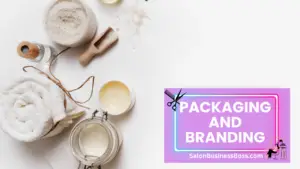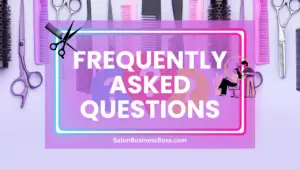Starting a hair business can be an exciting venture for aspiring entrepreneurs looking to capitalize on the booming beauty industry. However, like any business, success requires a well-thought-out plan and adequate financial investment.
It costs about an estimated $27,000 to start a hair business. This includes expenses for research and planning, legal fees, product sourcing, branding, marketing, and more. A well-prepared investment sets the foundation for a successful and profitable venture in the thriving beauty industry.
1. Research and Planning Costs (Approx. $1,000):

Before embarking on the exciting journey of starting a hair business, thorough preparation is essential to set the stage for success. Market research and a well-crafted business plan are the cornerstones of a prosperous venture. Allocating approximately $1,000 for this initial phase is a prudent investment that will yield long-term benefits.
Market research is the foundation upon which every decision in the hair business is built. Understanding the market landscape, identifying target demographics, and analyzing competitors’ strategies are crucial steps to gain a competitive edge. With a budget of $1,000, entrepreneurs can access valuable market research reports, which offer insights into trends, consumer preferences, and market demands.
Seeking guidance from experts in the beauty industry is invaluable. Allocating funds for consultation fees allows aspiring hairpreneurs to tap into the knowledge and experience of professionals who have thrived in the same space. These experts can provide guidance on industry best practices, potential challenges, and growth opportunities, helping you make informed decisions.
A comprehensive business plan, shaped by the insights gained from market research and expert advice, serves as a roadmap for the hair business. It outlines the company’s mission, vision, goals, target audience, marketing strategies, financial projections, and operational plans. This blueprint not only aids in securing funding from potential investors or lenders but also acts as a strategic guide throughout the initial stages and beyond.
Read more about: Know Before You Go: Understanding Salon Set Up Cost
2. Business Registration and Legal Fees (Approx. $500):
Operating a hair business legally is a crucial step to ensure compliance with regulations and safeguard the venture’s credibility. To achieve this, entrepreneurs must complete essential legal formalities, which typically involve business registration, obtaining licenses, and acquiring necessary permits. Allocating an estimated cost of around $500 for these processes is a prudent investment that ensures the business operates smoothly and avoids potential legal pitfalls.
Business registration is the first step in establishing a legally recognized entity. Depending on the business structure (sole proprietorship, partnership, LLC, etc.) and the location, registration fees may vary. This expense covers the administrative costs associated with obtaining a unique business name and securing legal recognition from government authorities.
Legal counsel is another vital aspect that aspiring hairpreneurs should consider. Engaging the services of an attorney with expertise in business and commercial law can help navigate complex legal requirements specific to the beauty industry. The attorney can provide invaluable guidance in drafting contracts, handling intellectual property matters, and ensuring compliance with local business regulations.
Regulatory compliance expenses encompass the costs associated with obtaining the necessary licenses and permits. The hair business may require specific permits related to health and safety standards, sanitation, and environmental regulations. Investing in these permits ensures that the business operates legally and maintains a reputation for professionalism and adherence to quality standards.
3. E-commerce Website Development (Approx. $3,000):
In the digital era, establishing a strong online presence is a business imperative, and for a hair business, a professional e-commerce website is paramount. This virtual storefront serves as the gateway to your brand, allowing you to showcase an extensive range of hair products, manage sales, and deliver a seamless customer experience.
Allocating around $3,000 for website development is a strategic investment that pays dividends in the long run. The bulk of this budget will go towards hiring experienced web developers to design and create a visually appealing and user-friendly website. This includes implementing an intuitive navigation system, incorporating high-quality product images, and ensuring responsive design for various devices.
A portion of the budget will cover website hosting and domain registration fees. Quality hosting ensures your website remains accessible and performs optimally, even during peak traffic periods. Regular maintenance is equally crucial to address technical issues promptly and keep your website secure and up to date.
By investing in a well-crafted e-commerce platform, your hair business gains a competitive edge, attracting and retaining customers through a streamlined shopping experience, secure payment options, and efficient order processing. A robust online presence can significantly contribute to your business’s growth and profitability.
4. Product Sourcing and Inventory (Approx. $12,000):
A successful hair business relies on offering high-quality and diverse products to cater to the demands of a discerning customer base. Sourcing top-notch hair extensions, wigs, and related accessories is a substantial investment, with the cost varying based on product types, brands, and suppliers.
Allocating an estimated budget of $12,000 for product sourcing and inventory is a prudent decision that allows you to stock a wide array of products, catering to various hair types, styles, and trends. Conducting extensive research and establishing partnerships with reputable suppliers ensure that your hair business maintains a reputation for delivering premium and sought-after products.
Diversifying your inventory enhances customer satisfaction and increases the chances of repeat business and word-of-mouth referrals. From natural human hair extensions to trendy synthetic wigs, investing in product variety positions your hair business as a one-stop-shop for all haircare needs.
Having a well-stocked inventory allows your hair business to capitalize on seasonal trends and respond swiftly to market demands. Ensuring sufficient stock levels prevent customer frustration due to out-of-stock items and bolsters your brand’s credibility and reliability.
5. Packaging and Branding (Approx. $1,500):

In the highly competitive hair industry, establishing a strong brand identity is paramount to capturing the attention and loyalty of customers. Allocating around $1,500 for packaging and branding is a strategic investment that ensures your hair business stands out amidst the sea of competitors.
Professional logo design is the cornerstone of your brand’s visual representation. A well-crafted logo conveys the essence of your hair business and leaves a lasting impression on customers. It should be versatile enough to be used across various marketing channels, from your e-commerce website to social media platforms.
Product packaging is equally important, as it plays a significant role in creating a positive customer experience. Eye-catching and thoughtfully designed packaging not only protects the products but also enhances their perceived value. Consider eco-friendly packaging options to align with the growing eco-conscious consumer base.
Branding materials encompass a range of elements, including business cards, flyers, and promotional materials that reinforce your brand identity. Allocating a portion of the budget for these materials ensures consistency across all touchpoints, reinforcing your brand’s credibility and professionalism.
A cohesive and appealing brand image fosters brand recognition and loyalty, making your hair business memorable to customers and encouraging repeat purchases. It also sets the stage for effective marketing strategies, attracting a loyal customer base that resonates with your brand’s values.
Read more about: How to Run a Successful Hair Business: Standing Out from Competitors
6. Marketing and Advertising (Approx. $4,000):
In the dynamic world of hair business, effective marketing and advertising strategies are the engines that drive growth and success. Allocating about $4,000 for marketing initiatives is a smart investment to build brand awareness, attract potential customers, and drive sales.
Social media campaigns are essential in today’s digital landscape. By leveraging popular platforms like Instagram, Facebook, and TikTok, you can showcase your products, engage with customers, and tap into a vast online community. Collaborating with influencers who align with your brand values can significantly amplify your reach and credibility.
Search engine optimization (SEO) and search engine marketing (SEM) are vital tools to ensure your website ranks high on search engine results, increasing visibility and organic traffic. Investing in targeted keywords and ad campaigns can yield a high return on investment (ROI).
Other promotional activities, such as email marketing, affiliate programs, and content marketing, can further boost your hair business’s online presence and customer engagement. Engaging storytelling, educational content, and limited-time offers can entice potential customers to make a purchase.
7. Equipment and Supplies (Approx. $1,000):
Running a hair business involves handling various products and fulfilling customer orders efficiently. This requires specific equipment and supplies to streamline operations and maintain product quality. While the cost of equipment and supplies can vary based on the scale of your business, budgeting around $1,000 is a reasonable estimate.
Equipment may include hair styling tools, mannequin heads for display and practice, hair extension application tools, and wig stands. These tools ensure that your hair business can offer a professional and comprehensive service to customers.
Additionally, investing in packaging materials, such as boxes, bubble wrap, and shipping labels, is essential for secure and attractive product packaging. Good packaging not only protects the products during transit but also leaves a positive impression on customers.
Order fulfillment supplies, such as shipping labels, packing slips, and packing tape, are crucial for efficiently managing and processing customer orders. Organized and timely order fulfillment contributes to customer satisfaction and repeat business.
Investing in the right equipment and supplies ensures that your hair business operates smoothly, meets customer expectations, and delivers a high-quality service, contributing to long-term success in the competitive beauty industry.
8. Website and Data Security (Approx. $500):
In the digital age, safeguarding your e-commerce website and customer data is of utmost importance. Allocating around $500 for website and data security measures is a necessary investment to protect your business and build trust with customers.
Website security measures, such as firewall protection and malware scanners, help prevent unauthorized access and attacks on your website. Regular security updates and monitoring are essential to address vulnerabilities promptly.
Acquiring an SSL certificate is crucial to encrypt sensitive customer information during online transactions. This security feature ensures that customer data, such as payment details, remains confidential and protected from potential cyber threats.
Data protection also extends to compliance with data privacy regulations. Ensuring that your website is compliant with relevant data protection laws reinforces your commitment to customer privacy and builds credibility.
9. Shipping and Fulfillment (Approx. $2,000):

Shipping and fulfillment costs play a crucial role in the overall customer experience and the success of your hair business. Allocating approximately $2,000 for these expenses ensures that your business can efficiently manage shipping logistics and deliver products promptly to customers.
Shipping fees can vary based on the weight and size of the packages, delivery destinations, and the chosen shipping carriers. Offering competitive shipping rates can attract more customers and increase conversion rates.
Investing in packaging materials, such as boxes, envelopes, and padding, ensures that your products are adequately protected during transit. Well-packaged items reduce the risk of damages and returns, contributing to customer satisfaction.
Order fulfillment services, especially for larger hair businesses, can also be part of the budget. Fulfillment centers can handle storage, packaging, and shipping on your behalf, streamlining operations and allowing you to focus on other aspects of your business.
Efficient shipping and order fulfillment contribute to positive customer reviews and repeat business. Satisfied customers are more likely to recommend your hair business to others, expanding your customer base and contributing to sustainable growth.
Read more about: Breaking Barriers: Starting a Hair Business from Home
10. Miscellaneous Expenses (Approx. $1,500):
In the entrepreneurial journey, unexpected expenses are inevitable. Setting aside approximately $1,500 as a buffer for miscellaneous costs and unforeseen circumstances is a prudent practice to maintain financial stability and avoid disruptions in your hair business operations.
Miscellaneous expenses may include unexpected repairs or maintenance for equipment, unforeseen marketing opportunities, unforeseen travel expenses related to business events or expos, or any other unplanned costs that may arise during the course of your business.
By having a dedicated fund for miscellaneous expenses, you can address unexpected challenges without impacting your hair business’s regular operations or straining your financial resources. This buffer allows for flexibility and adaptability, crucial traits for navigating the ever-changing business landscape.
Having a contingency budget ensures that your hair business can weather unexpected challenges and seize opportunities for growth and expansion when they arise. It also provides peace of mind, knowing that you have the resources to handle unforeseen situations confidently.
Conclusion
Launching a hair business requires careful planning and financial investment. From conducting thorough research to investing in product inventory and marketing, the estimated total cost of approximately $27,000 will set the foundation for a successful and sustainable venture. While these figures may vary based on individual circumstances and business goals, this breakdown provides a comprehensive overview to help aspiring hairpreneurs embark on their entrepreneurial journey with confidence. Remember, dedication, passion, and strategic decision-making are key factors in turning your hair business into a thriving enterprise.
Frequently Asked Questions

1. Can I cut costs on website development?
While it’s crucial to have a professional e-commerce website, you can explore cost-effective options or DIY platforms to save on website development expenses.
2. What are the common miscellaneous expenses?
Miscellaneous expenses of around $1,500 should cover unexpected costs that may arise during the initial stages of your hair business.
3. Do I need to invest in product packaging and branding?
Yes, allocating about $1,500 for product packaging and branding ensures a cohesive and attractive brand image, contributing to customer satisfaction and loyalty.
To learn more on how to start you own salon checkout my startup documents here.
Please note that the contents of this blog are for informational and entertainment purposes only and should not be construed as legal advice. Any action taken based on the information provided in this blog is solely at your own risk. Additionally, all images used in this blog are generated under the CC0 license of Creative Commons, which means they are free to use for any purpose without attribution.

About the author. Entrepreneur and Salon Business Fan.
Hi! I am Shawn and I am a happy individual who happens to be an entrepreneur. I have owned several types of businesses in my life from a coffee shop to an import and export business to an online review business plus a few more and now I create online salon business resources for those interested in starting new ventures. It’s demanding work but I love it. I do it for those passionate about their business and their goals. That’s why when I meet a salon business owner, I see myself. I know how hard the struggle is to retain clients, find good employees and keep the business growing all while trying to stay competitive.
That’s why I created Salon Business Boss: I want to help salon business owners like you build a thriving business that brings you endless joy and supports your ideal lifestyle.

